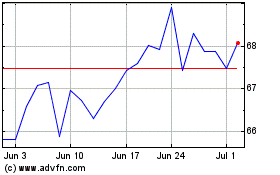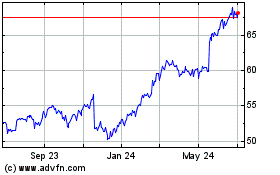By Michael C. Bender and Brianna Abbott
WASHINGTON -- The Trump administration is prepared to send all
50 states enough tests to screen at least 2% of residents for the
new coronavirus, a senior administration official said Monday, with
the aim of rapidly expanding supplies in the coming weeks as the
nation's leaders look to reopen parts of the economy.
The comments came as President Trump met with heads of major
retailers, pharmacy chains and testing labs on Monday, including
Walmart Inc. and CVS Health Corp., and the White House released
what it called a blueprint on its testing plans.
"We're deploying the full power and strength of the federal
government to help states, cities, to help local governments get
this horrible plague over with," Mr. Trump said in a Rose Garden
press conference, in which he was joined by several executives.
Adm. Brett Giroir, the administration official overseeing
coronavirus testing efforts, said the federal government would be
able to supply every state with the supplies and tests they need to
"dramatically increase" the number of tests.
The lack of widely available coronavirus tests has been a chief
complaint from business leaders whom the Trump administration
leaned on for economic advice. Mr. Trump told reporters on March 6
that anyone who wanted a test could get a test, a promise that
remains unfulfilled.
In separate statements on Monday, CVS said it will expand its
coronavirus testing operations, offering self-swab tests at as many
as 1,000 of its pharmacy parking lots and drive-thru windows by the
end of May, with the goal of processing up to 1.5 million tests a
month. Rival Walgreen Boots Alliance Inc. also said it is ramping
up testing capacity.
Walmart is supporting 20 self-swab test sites in 12 states and
expects by the end of May to be operating over 100, the company
said. The country's largest retailer, with roughly 4,800 U.S.
stores, said it will focus on hot spots and underserved
communities.
About 5.4 million Americans have been tested for the virus so
far, according to the COVID Tracking Project, or about 1.6% of the
population. Laboratories across the U.S. are currently processing
about one million tests per week, but public health experts say
that testing still needs to be greatly expanded in most communities
in order to quickly identify and isolate cases and move out of
lockdowns safely.
The administration official said that testing 2% of each state's
population was the minimum needed to maintain public health, but
experts who have studied the matter say that level is short of what
is needed.
"It's about 6 to 7 million, and if that's one-time, that doesn't
do anything," said Ashish Jha, director of the Harvard Global
Health Institute.
Experts would like four million or more people tested per week
nationwide, in order to cast a wide net and cover a significant
percentage of the population not already known to be sick, or even
to have symptoms. States including Georgia and New York have
already tested more than 2% of their populations.
Democrats also criticized the White House's blueprint. Sen Patty
Murray (D., Wash.) said it didn't "offer any details whatsoever on
expanding lab capacity or activating needed manufacturing
capacity."
One roadblock to scaling-up testing has been a lack of swabs and
chemical reagents needed to collect patient samples, though those
shortages are starting to ease, laboratory officials say.
The administration was prepared to provide some states with
enough kits to quadruple the number of coronavirus tests that have
been performed to date, one senior administration official said,
adding that "the hope is that by fall we've got so many tests that
we're swimming in tests."
Also on Monday, the U.S. Centers for Disease Control and
Prevention widened who should be considered a high priority for
testing. First responders and people living and working in nursing
facilities, prisons and shelters are now a top priority if they
have symptoms, along with people identified through public health
investigations.
Previously, the CDC only listed hospitalized patients and
health-care workers with symptoms as the highest priorities for
testing, with high-risk patients and first responders with symptoms
at a lower tier. Criteria for Covid-19 diagnostic testing in the
U.S. has been largely limited in the past due to the lack of
available tests, with hospitals and health authorities rationing
tests among the most severely ill or symptomatic employees.
The new list now also includes people without symptoms if deemed
appropriate by public health departments or clinicians "for any
reason," such as public health monitoring or surveillance, though
the update stops short of making them a top priority.
The CDC also recently added several symptoms to its watch list
for Covid-19, including muscle pain, headaches, sore throat and a
new loss of taste or smell.
--Thomas M. Burton contributed to this article.
Write to Michael C. Bender at Mike.Bender@wsj.com and Brianna
Abbott at brianna.abbott@wsj.com
(END) Dow Jones Newswires
April 27, 2020 19:49 ET (23:49 GMT)
Copyright (c) 2020 Dow Jones & Company, Inc.
Walmart (NYSE:WMT)
Historical Stock Chart
From Mar 2024 to Apr 2024

Walmart (NYSE:WMT)
Historical Stock Chart
From Apr 2023 to Apr 2024
